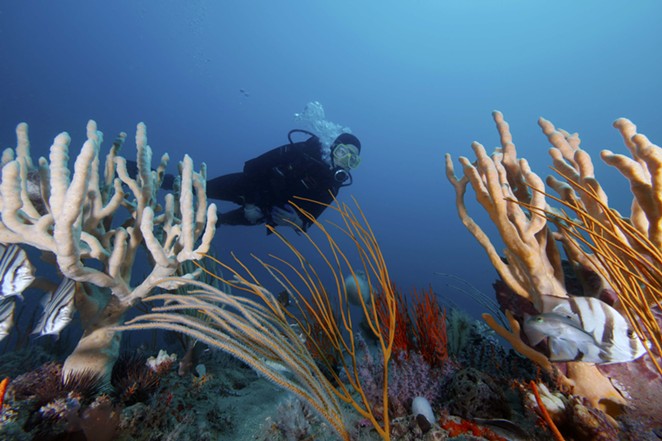click to enlarge 
Courtesy of Gray’s Reef National Marine Sanctuary
A diver examines fish and sponges at Gray’s Reef National Marine Sanctuary.
The wonders of Gray’s Reef National Marine Sanctuary are being brought to shore, expanding the potential of greater community engagement with Georgia’s own natural underwater park.
Gray’s Reef, an undersea habitat located 19 miles east of Sapelo Island on Georgia’s coastline, was designated as a National Marine Sanctuary on Jan. 16, 1981, as one of the last official acts by President Jimmy Carter. To honor that day 40 years ago, Savannah Mayor Van Johnson designated this upcoming Jan. 16 as the city’s inaugural Gray's Reef National Marine Sanctuary Day.
Looking ahead, Gray’s Reef administrators have received approval to open a marine-sanctuary visitor center in downtown Savannah to provide the community with an onshore location to learn more about the oceanic landmark and find out how to embark upon underwater adventures there.
The leadership of Gray’s Reef considers Savannah’s official celebration of the sanctuary’s 40th anniversary and the new visitor center as important steps.
“It’s a look back of where we’ve been, and where we’re going,” said Stan Rogers, the sanctuary’s superintendent. “We want more and more people to get involved and engaged.”
click to enlarge 
Courtesy of Gray’s Reef National Marine Sanctuary
A diver examines fish and sponges at Gray’s Reef National Marine Sanctuary.
Gray’s Reef National Marine Sanctuary is the only natural protected reef off the coast of Georgia, and it is one of the largest near-shore “live bottom” reefs of the southeastern U.S. It is one of only 14 protected marine areas that make up the National Marine Sanctuary System. The approximately 22-square-mile sanctuary of Gray's Reef is just a small part of the U.S. territorial Atlantic Ocean, yet its value as a natural marine habitat is recognized nationally and internationally.
“Gray’s Reef is 19 miles off the coast. It requires a boat and/or the ability to scuba dive to actually see the reef, so we do a lot to interpret that to bring that to the people so that they can experience it virtually even if they can’t go out to the sanctuary,” said Rogers.
Since most people will never get to visit the reef in person, staffers have been working to bring the experience of its bountiful maritime life on land. Rogers says that some prospective plans include the incorporation of free educational classes taught by National Oceanic and Atmospheric Administration scientists, as well as volunteer opportunities and public Advisory Council meetings to engage the community.
The visitor center experience may include digital multimedia galleries equipped with touch-tables and virtual-reality headsets that simulate an actual reef visit. The site will feature appropriate materials for the education and enjoyment of all ages. Rogers anticipates opening the center by fall of 2021.
In November 2020, former President Carter wrote a special letter to the director of the Office of National Marine Sanctuaries, John Armor, honoring the reef’s 40th anniversary. In the letter, he also acknowledged the other three marine sanctuaries that he designated on that day: Channel Islands, Looe Key, and Point Reyes - Farallon Islands.
“What we want is to engage more people and get more people involved by letting them know how they can be involved and support the sanctuary,” Rogers said. “Everyone holds value in Georgia’s coast and all of the great resources it provides. Whether they visit the coast or not, everyone benefits from it and its resources.”
Gray’s Reef staffers are enthused about engaging the community in future endeavors.
“We are super-excited, because most people will never go to Gray's Reef, so it’s our job to bring the wonders of Gray’s Reef to them on land,” said Michelle Riley, the sanctuary’s communications and public outreach coordinator. “After all, the sanctuary belongs to all Americans!”
Visit
graysreef.noaa.gov to learn more about the Gray’s Reef National Marine Sanctuary.



